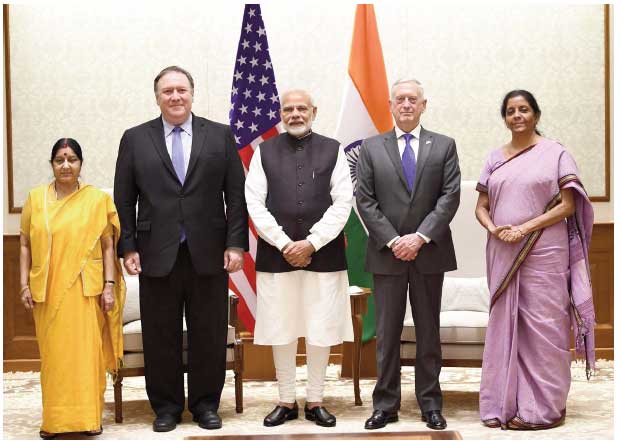A strategic milestone
 M.R.Dua
M.R.Dua
 PM Modi with U.S. Secretary Mike Pompeo, Secretary James Mattis, Sushma
Swaraj and Nirmala Sitharaman
PM Modi with U.S. Secretary Mike Pompeo, Secretary James Mattis, Sushma
Swaraj and Nirmala Sitharaman
Widely commended and univocally
welcomed, the India-America
deal, popularly termed 2+2
Dialogue is the new cornerstone
of bilateral relations of the world’s
two largest democracies. This agreement was described as ‘a foundational defence
partnership’ between India and the U.S.
However, the moot question is : how far and how
much will the Trump administration the terms of the
twice-postponed 2+2 Dialogue? This question arises because President Trump is known for changing his
decisions.
India’s accord with the US is probably the second
most monumental agreement signed in recent years
during a Republican President’s regime, the first being
during President George W. Bush’s White House term.
It was then known as a ‘strategic milestone,’ relating to
civil nuclear cooperation, signed in 2005, and
operationalized in 2008.
This time when the two senior members of the
Donald Trump cabinet, secretary of state Michael
Pompeo and defence secretary James Mattis, met
India’s external minister Sushma Swaraj, and defence
minister Nirmala Sitharaman, and cleared several
security defence and energy--related projects on
September 6 in New Delhi.
‘It was more than a
meeting,’ proclaimed Alice
Well, a senior official of the
Trump administration, the
principal deputy assistant
secretary of state for south
and central Asia, who was a
member of the U.S.
negotiating team in Delhi.
She further added, ‘we view
it as a strategic milestone
about our shared vision for
the future.’
The 10-year deal is
believed to have already
come into effect. Another
top US defence official,
Marine General Joseph
Dunford, who accompanied
the U.S. team, termed the
dialogue as ‘an historic
opportunity to develop our
growing partnership and
explore ways of enhancing our security cooperation.’
There’s no doubt that the 2+2 deal is full of potentials,
subject, of course, to the US President Trump’s whims
and fancies.
The September 6 deal has identified at least half a dozen projects under the umbrella of COMCASA—
communications compatibility and security. In real
terms, it is deemed to be a basic and ‘foundational
imperative’ for the India-U.S. military ties. Under this
arrangement,the U.S. and India will review and
monitor national security implications, outlined
earlier in the 2016 agreements.
For India, the COMCASA is expected ‘to facilitate
access to advanced defence systems and enable India
to optimally utilize its existing US-origin
platforms,’and the supply of the
sensitive defence equipment and
armed version of Guardian drones.
Yet another item in the accord
includes, a Basic Exchange and
Cooperation Agreement (BECA), for
‘sharing advanced satellite data for
navigation and missile targeting’
would replenish India’s defence.
Incidentally, India has purchased
defence equipment from the U.S
worth nearly $15 billion in the last
10 years.
It’s good to hope for a bright
future for Indo-US ties. But it
must not be overlooked that
President Trump’s own
residency is perilously hung
on the Special Counsel,
Robert Mueller’s report of his
probe into the alleged
dubious means adopted by
the multi-layered Trump
campaign with Russian spies
for winning the 2016
presidential election, and
many other fraudulent
irregularities resorted by his
poll staff for over two years
during 2015 and 2016.
It’s firmly believed that that
these ‘advanced’ systems may not
be of any great use for India due to
some inherent restrictions listed in
the agreement—but not yet made
public. At the same time, it’s also
true that America has entered into
such an agreement only with some
of its select allies.
The US is still to give its consent
to India’s progamme to buy S-400 missile system from
Russia. India is determined to go ahead with this
purchase at any cost strengthen to its ties with Russia.
In addition to the COMCASA, the U.S. has reportedly
mounted intense influence on India to sign and
upgrade its trade with it, so as to bring its balance of
trade with Washington at bilaterally--acceptable
levels. President Trump has expressed his earnest
wish ‘to start doing a trade deal, first time with India.’
Meanwhile, the two countries will regularly conduct
‘tri-military exercises’ with their army, navy and air
force. Though the U.S. has not yet adequately
comprehended India’s innate need and compulsion to
buy Iranian oil, America desires that India should
cease or dramatically cut down the quantity, by
November 4 next, that New Delhi proposes to buy
from Tehran. True, President Trump has declared his
instinctive ‘likeness’ and ‘friendship’ with Prime
Minister Modi. Still, no one is sure whether the
president would revise his decisions on H1-B visa for
Indian workers in the U.S.
Trump has reportedly issued many terse statements
on trade and tariffs on Indian goods. However, India
fervently hopes that the U.S. will waive sanctions on
India’s purchase of Iranian oil, and Russian defence
equipment, particularly the S-400 ‘Triumf’ air defence
missile system. This has been finalized with Moscow,
and may be signed with the
Russian President Vladimir
Putin when Modi visits
Moscow for his annual
summit.
India also expects America’s
diplomatic and political
support on its numerous
conflicting issues with China,
e.g., Beijing’s implicit,
sometimes even clear direct,
pitch for Pakistan, besides its
vote on many of India’s crucial
global matters which are stuck
in the UN security council.
Of late, as revealed by a
recent book on Trump’s nearly
20-month duration in the
White House, U.S. President
Trump has reportedly
expressed immense fondness
for Narendra Modi.
As it happens, India seems
to be privy to enjoying American president’s abundant
goodwill and excellent camaraderie. One senior White
House official recently predicted the widening
parameters of the Indo-U.S.mutual relationship
forecasting: ‘We have a very full and ambitious agenda
for the 2+2, including advancing our shared vision for
the Indo-Pacific,’ and many other ‘concrete
outcomes.’
Finally, it’s good to hope for a bright future
for Indo-US ties. But it must not be overlooked that
President Trump’s own residency is perilously hung on
the Special Counsel, Robert Mueller’s report of his
probe into the alleged dubious means adopted by the
multi-layered Trump campaign with Russian spies for
winning the 2016 presidential election, and many
other fraudulent irregularities resorted by his poll
staff for over two years during 2015 and 2016.




 M.R.Dua
M.R.Dua PM Modi with U.S. Secretary Mike Pompeo, Secretary James Mattis, Sushma
Swaraj and Nirmala Sitharaman
PM Modi with U.S. Secretary Mike Pompeo, Secretary James Mattis, Sushma
Swaraj and Nirmala Sitharaman